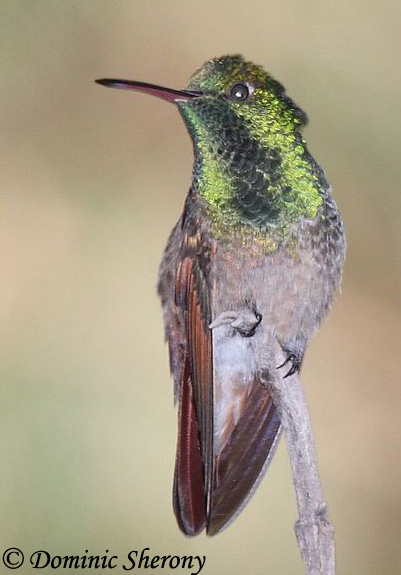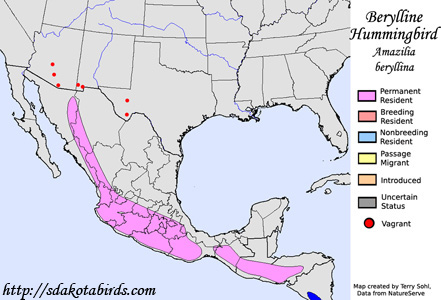Berylline Hummingbird
Amazilia beryllina
| Length: 4.25 inches | Wingspan: 5.75 inches | Seasonality: Non-resident in South Dakota |
| ID Keys: Rufous-colored wings and tail, dark green overall, gray belly | ||
 The
Berylline Hummingbird is quite common in and around upland forests of
Mexico, but wasn't found in the United States until the 1960s. The
species has been found occasionally since then, most often in the mountain
canyons of Arizona, but also in New Mexico and Texas. They are closely
related to the Buff-bellied Hummingbird, but the grey belly and
rufous-colored wings set it apart from that species.
The
Berylline Hummingbird is quite common in and around upland forests of
Mexico, but wasn't found in the United States until the 1960s. The
species has been found occasionally since then, most often in the mountain
canyons of Arizona, but also in New Mexico and Texas. They are closely
related to the Buff-bellied Hummingbird, but the grey belly and
rufous-colored wings set it apart from that species.
Habitat: Berylline Hummingbirds are typically found mountain forests and canyon forests. Those found in Arizona have typically been found in mountain canyons. In Mexico, they are also found on forested slopes of mountains, lower slopes, and adjacent brushy areas.
Diet: Typical diet of Hummingbirds, feeding heavily on nectar. Insects can comprise a large portion of the diet.
Behavior: Berylline Hummingbirds are relatively aggressive, like other hummingbirds, and will defend a small feeding territory from intruders.
Nesting: Nesting can occur at a wide variety of heights, although nests are often found below 10 feet. Those few that have been found nesting in Arizona higher up in sycamore trees. The nest is made of plant fibers woven together with spider webs, with lichens decorating the outside of the nest, and typically with grasses or other plant material to line the inside of the nest.
Interactive eBird Map: Click to access an interactive eBird map of Berylline Hummingbird sightings
Song: Song of the Berylline Hummingbird is a squeaky, crackly series of notes.
Migration: Most birds are non-migratory. Strays to the U.S. typically show up in the summer months. Birds in higher-elevation portions of its Mexican range may move to lower elevations in the winter.
Feeders: Will attend hummingbird feeders
Similar Species: Buff-bellied Hummingbird
Conservation Status: The species is still common and widespread throughout its normal Mexican range. However, it may be locally susceptible to habitat loss where forest clearing is occurring.
Further Information: 1) Cornell's Neotropical Birds - Berylline Hummingbird
2) West Texas Hummingbirds - Berylline Hummingbird
3) WhatBird - Berylline Hummingbird
Image Information: August 2010 - Taken in Mexico - Dominic Sherony
Additional Photos: Additional Photos Coming Soon!!
| Click below for a higher-resolution map |
 |
| South Dakota Status: Non-resident in South Dakota |
Additional Berylline Hummingbird Photos (coming soon!!)
